Guide photographique des étiquettes
des disques Deutsche Grammophon
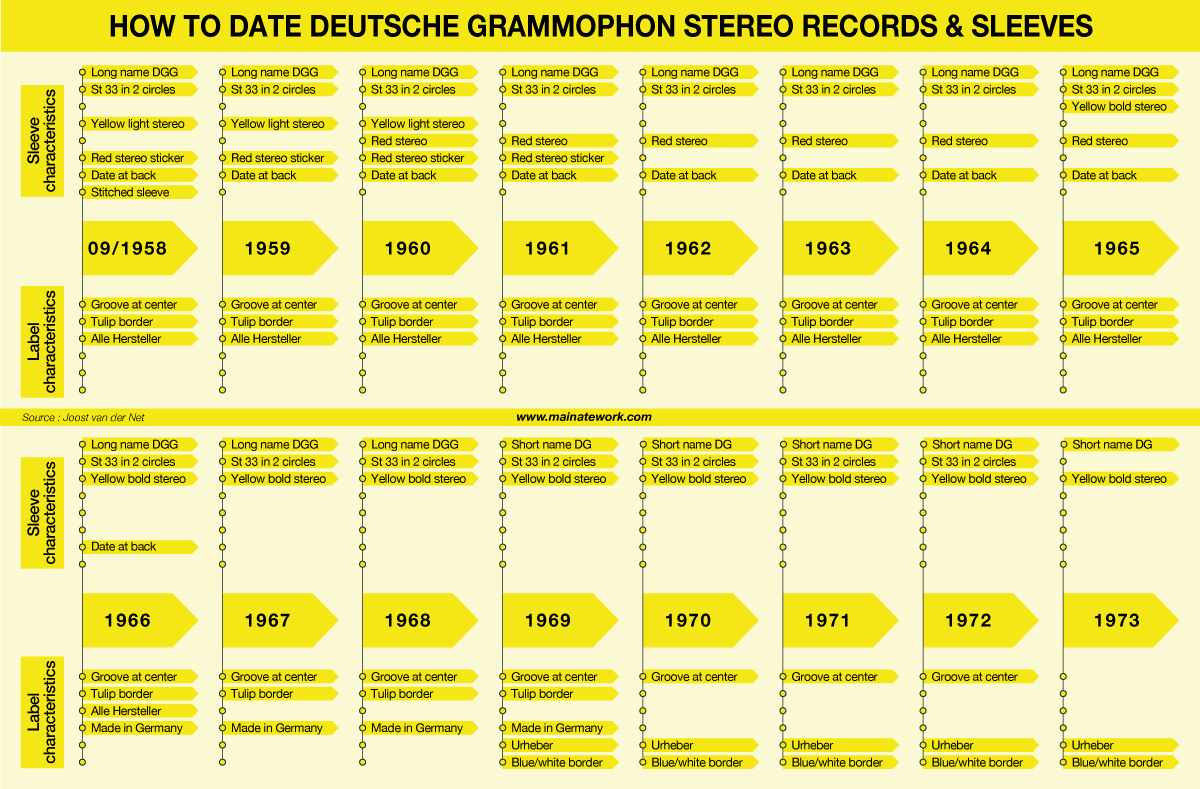
Le tableau (au format pdf) est disponible ici : → How to date Deutsche Grammophon records and sleeves?
Nomenclature des étiquettes des disques Deutsche Gramophon
→ Voir aussi le guide des pochettes
→ Voir aussi le catalogue des enregistrements numériques (« Digital Aufnahme »)
→ Voir aussi la page des catalogues téléchargeables en pdf
Série LP
10” – 33 tours – Mono
16 xxx
Début/milieu des années 1950 – 1966
Série LPE
10” – 33 tours – Mono
17 xxx
Début/milieu des années 1950 – 1966
Série LPM
12” – 33 tours – Mono
18 xxx
Début/milieu des années 1950 – 1966
Série LPEM
12” – 33 tours – Mono
19 xxx
Milieu des années 1950 – 1966
Série SLP
10” – 33 tours – Stéréo
133 xxx
Durant les années 60
Série SLPM
12” – 33 tours – Stéréo
136 xxx
Durant les années 60
Série SLPEM
12” – 33 tours – Stéréo
138 xxx
139 xxx
Durant les années 60
Série 7 digits
12” – 33 tours – Stéréo
25xx xxx
27xx xxx
Introduit en avril 1970
Série – 7 digits – Stéréo Numérique
12” – 33 tours – Stéréo
2532 xxx
2707 xxx
2741 xxx
Introduit au début de l’année 1980
Série – 6 digits – Stéréo Numérique
12” – 33 tours – Stéréo
419 xxx
423 xxx
Série EPL
7” – 45 tours
EPL 30 xxx
Remarque
les pochettes de protection internes doublées utilisées pour certains pressages et rééditions indiquent généralement une date de fabrication en bas à droite. Par exemple 3/69 indique que la pochette de protection à été fabriquée en mars 1969. Ce n’est PAS un moyen totalement sûr de déterminer l’année exacte de sortie du disque, mais donne une idée de l’époque à laquelle il a été fabriqué.
Sources :
https://www.joostvandernet.nl/classical-music-on-lp/deutsche-grammophon-stereo-lps.html
http://lee.classite.com/music/dgg-lps/dg-6digits-intro.htm
https://www.discogs.com/fr/
Collection personnelle
| Etiquette – Label | Description – Description |
|---|---|
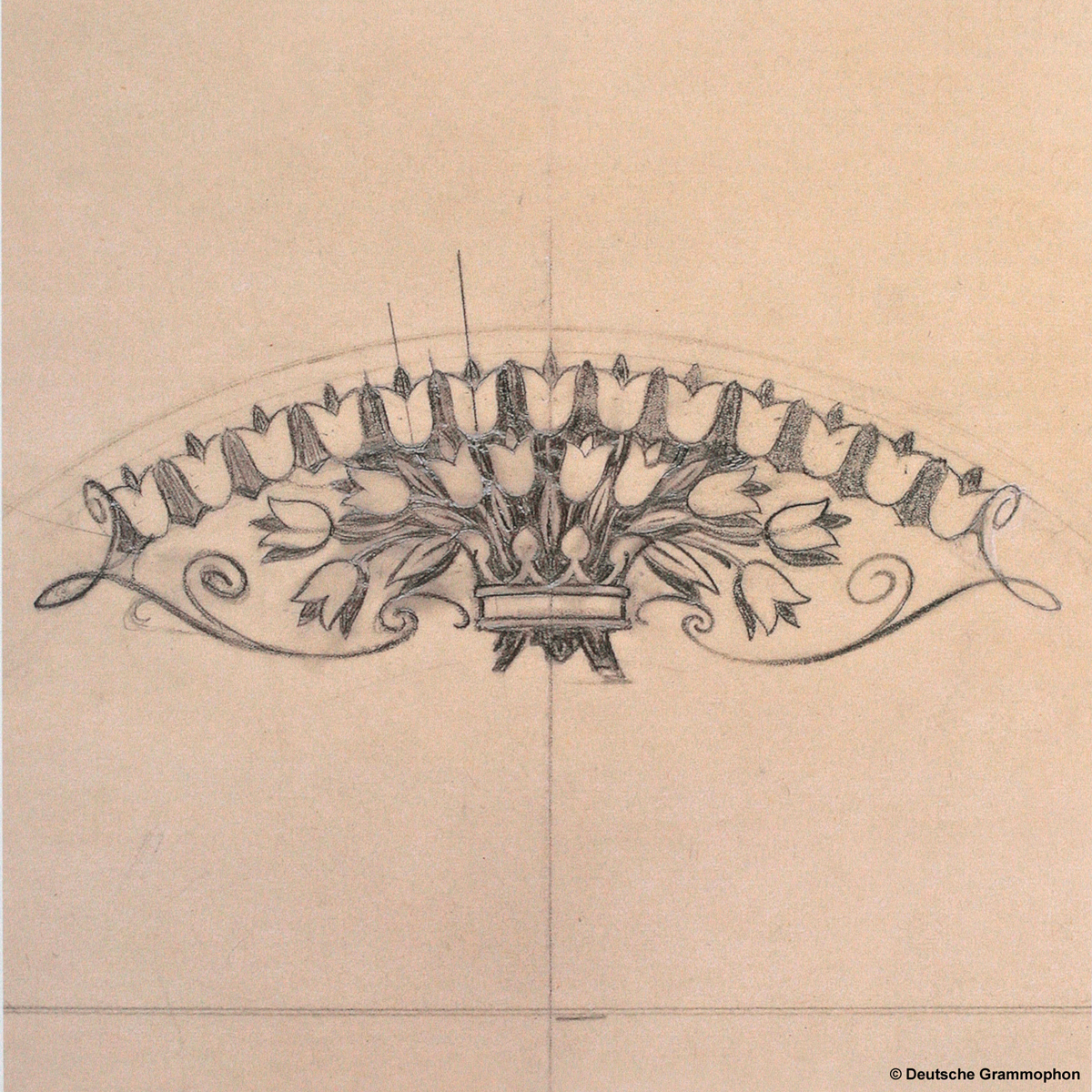 |
« Crown of Tulips » – Original Sketche – 1949 Esquisse originale (crayon sur papier calque) des « tulipes stylisées » ou « couronne de tulipes », conçues par Hans Domizlaff, qui ont caractérisé les couverture et étiquettes des disques Deutsche Grammophon à la fin des années 1940.Original sketche (pencil on tracing paper) of the « stylized tulips » or « crown of tulips », designed by Hans Domizlaff, that characterized Deutsche Grammophon’s cover and label of the records from the late 1940s onward.© Deutsche Grammophon |
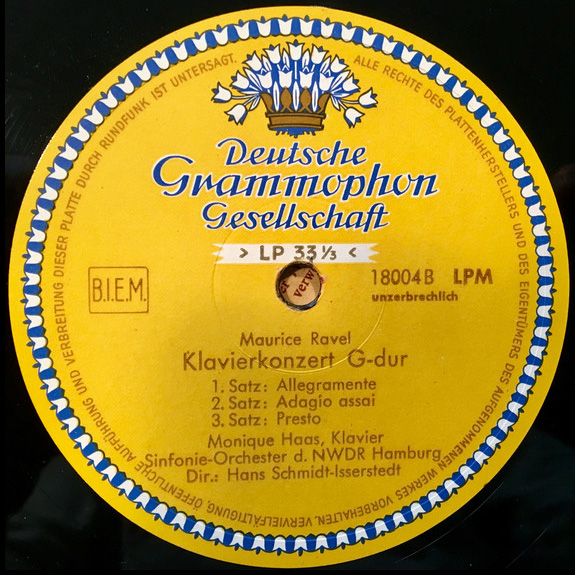 |
Série LPM – Tulip – Mono
L’étiquette est jaune. Dans la partie supérieure se trouve le logo « Tulipe » avec le texte « Deutsche Grammophon Gesellschaft » et le texte « LP 33 1/3 » sur fond blanc. Un sillon circulaire près du trou central. L’étiquette a le texte « Alle Rechte … » sur le périmètre et un bord tulipe. Elle est appelée GY1 (German Yellow 1st). The label is yellow. At the upper half are the « Tulip » logo with the text « Deutsche Grammophon Gesellschaft, and the text « LP 33 1/3 » on white background. A circular groove near the center hole. The label has text « Alle Rechte … » around the perimeter and a tulip rim. This is called GY1 (German Yellow 1st). |
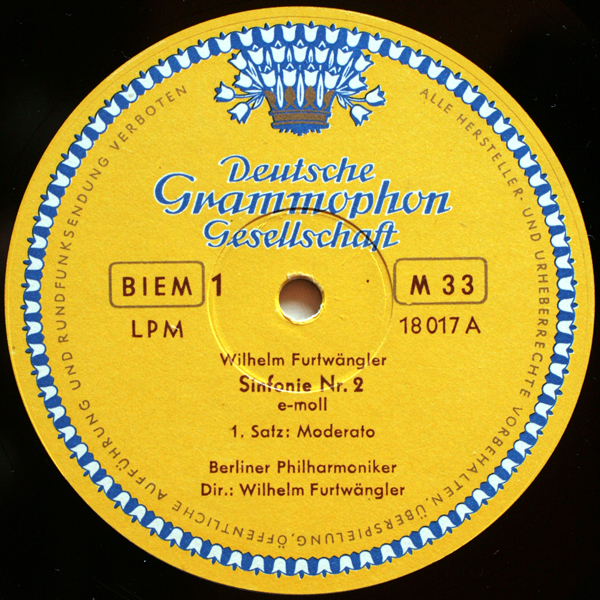 |
Série LPM – Tulip – Mono
L’étiquette est similaire à la GY1. Le texte « LP 33 1/3 » sur fond blanc disparaît et est remplacé par « M 33 » dans un cartouche rectangulaire. Un sillon circulaire près du trou central. L’étiquette a le texte « Alle Rechte … » sur le périmètre et un bord tulipe. Elle est appelée GY2 (German Yellow 2nd). The label is similat to the GY1. The text « LP 33 1/3 » on white background disappearsand is replaced by « M 33 » in a rectangle cartridge. A circular groove near the center hole. The label has text « Alle Rechte … » around the perimeter and a tulip rim. This is called GY2 (German Yellow 2nd). |
 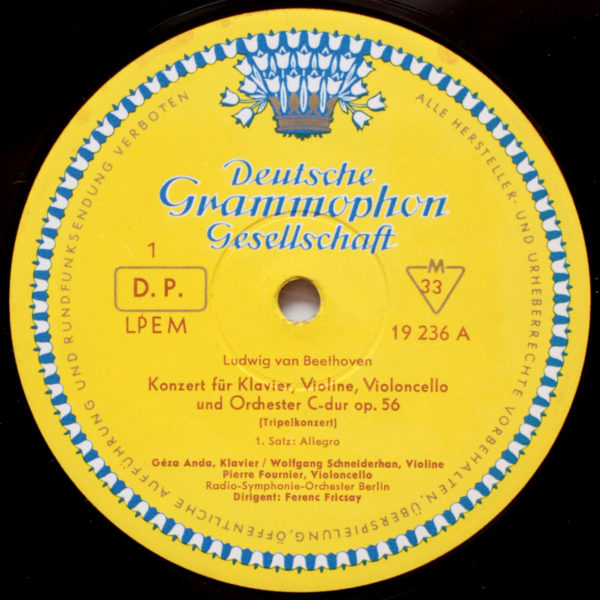 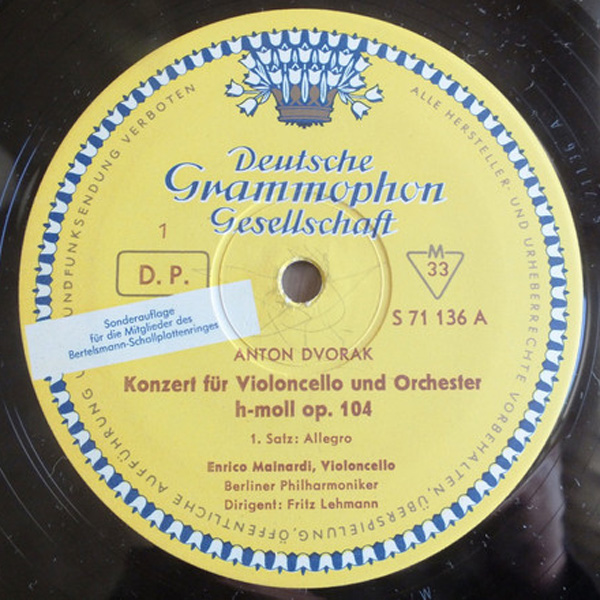 |
Série LPM – Tulip – Mono
L’étiquette est similaire à la GY2. Le texte « M 33 » est dans un cartouche triangulaire. Un sillon circulaire près du trou central. L’étiquette a le texte « Alle Rechte … » sur le périmètre et un bord tulipe. Elle est appelée GY3 (German Yellow 3rd). Une variante « Club Edition » avec le texte « Sonderauflage für die Mitglieder … » imprimé sur fond blanc (ce n’est pas une étiquette). Elle est appelée GY4 (German Yellow 4th). The label is similat to the GY2. The text « M 33 » is in a triangular cartridge. A circular groove near the center hole. The label has text « Alle Rechte … » around the perimeter and a tulip rim. This is called GY3 (German Yellow 3rd). A « Club Edition » variant with the text « Sonderauflage für die Mitglieder … » printed on a white background (this is not a sticker). This is called GY4 (German Yellow 4th). |
 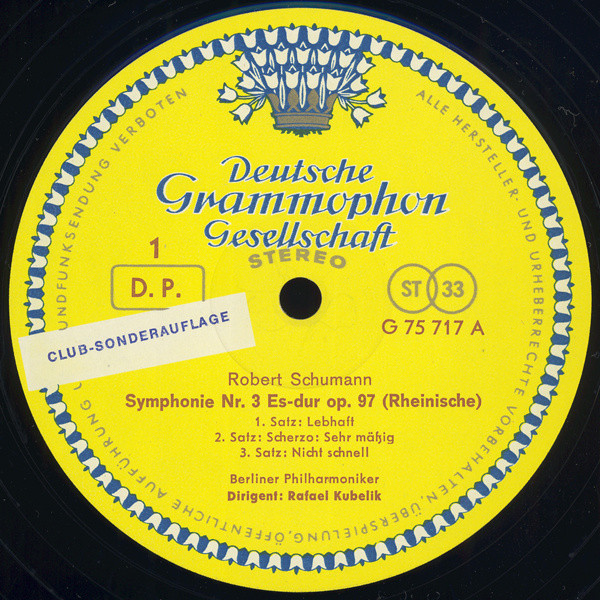 |
Série SLPM – Tulip – Stéréo
L’étiquette est similaire à la GY3. Le texte « Stereo » sur fond blanc apparaît au dessus du trou central. A droite, le texte « M 33 » est remplacé par « ST 33 » entouré par 2 cercles. L’étiquette a le texte « Alle Rechte … » sur le périmètre et un bord tulipe. Elle est appelée GY5 (German Yellow 5th). Une variante « Club Edition » avec le texte « Sonderauflage für die Mitglieder … » imprimé sur fond blanc (ce n’est pas une étiquette). Elle est appelée GY6 (German Yellow 6th). The label is similat to the GY3. The text « Stereo » on a white background appears above the center hole. On the right, the text « M 33 » is replaced by « ST 33 » surrounded by 2 circles. The label has text « Alle Rechte … » around the perimeter and a tulip rim. This is called GY5 (German Yellow 5th). A « Club Edition » variant with the text « Sonderauflage für die Mitglieder … » printed on a white background (this is not a sticker). This is called GY6 (German Yellow 6th). |
 |
Série SLPM – Tulip – Stéréo
L’étiquette est similaire à la GY4. Le texte « Stereo » sur fond blanc apparaît au dessus du trou central. A droite se trouve le texte « ST 33 » entouré par 2 cercles. Un nouveau texte « Made in England … » débute à 1 heure- et « Urheber und … » à 5 heures sur le périmètre. Elle est appelée GY7 (German Yellow 7th). The label is similat to the GY4. The text « Stereo » on a white background appears above the center hole. On the right is the text « ST 33 » surrounded by 2 circles. A new text « Made in England … » starts at 1 o’clock and « Urheber und … » at 4 o’clock around the perimeter. This is called GY7 (German Yellow 7th). |
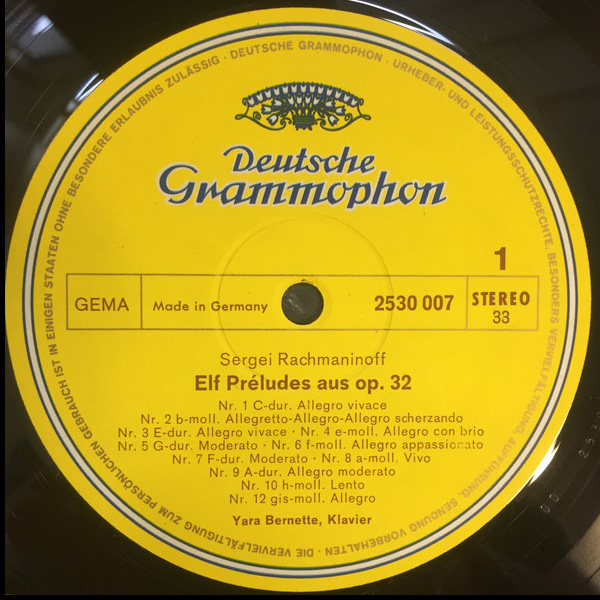 |
Série 7 digits – Stéréo
Fin 1969 apparaît une nouvelle étiquette. La bordure tulipe est remplacée par une nouvelle bordure bleu-blanc sans ornement. Le logo est plus petit et le mot « Gesellschaft » est supprimé. Le texte « Deutsche Grammophon » à 12 heures. Le texte « Made in germany by … » est supprimé et est remplacé par « Urheber und … » qui débute à 1 heure. Elle est appelée GY8 (German Yellow 8th). Towards the end of 1969 appéars a new label. The tulip-border is replaced by a new unadorned blue-white borderline. The logo is smaller and the word « Gesellschaft » is deleted. The text « Deutsche Grammophon » à 12 o’clock. The text « Made in germany by … » is deleted and is replaced by « Urheber und …' »starting at 1 o’clock. This is called GY8 (German Yellow 8th). |
 |
Série 7 digits – Stéréo – « Made in Austria » Fin 1969 apparaît une nouvelle étiquette. La bordure tulipe est remplacée par une nouvelle bordure bleu-blanc sans ornement. Le logo est plus petit et le mot « Gesellschaft » est supprimé. Le texte « Deutsche Grammophon » à 12 heures. Le texte « Made in germany by … » est supprimé et est remplacé par « Urheber und … » qui débute à 1 heure. Pressage fait en Autriche : « Made in Austria ». L’étiquette est identique à la GY8 (German Yellow 8th).Towards the end of 1969 appéars a new label. The tulip-border is replaced by a new unadorned blue-white borderline. The logo is smaller and the word « Gesellschaft » is deleted. The text « Deutsche Grammophon » à 12 o’clock. The text « Made in germany by … » is deleted and is replaced by « Urheber und …' »starting at 1 o’clock. Austrian pressing: « Made in Austria ». The label is tha same as GY8 (German Yellow 8th). |
 |
Série 7 digits – Stéréo
L’étiquette est similaire à la GY8. Le texte « Deutsche Grammophon » disparaît. Le texte « Alle Urheber und … » débute à 12 heures. Elle est appelée GY9 (German Yellow 9th). The label is similat to the GY8. The text « Deutsche Grammophon » disappears. The text « Alle Urheber und … » starts at 12 o’clock. This is called GY9 (German Yellow 9th). |
 |
Série 7 digits – Stéréo
L’étiquette est similaire à la GY8. Le texte « Urheber und … » débute à 9 heures. Elle est appelée GY10 (German Yellow 10th). The label is similat to the GY8. The text « Urheber und … » starts at 9 o’clock. This is called GY10 (German Yellow 10th). |
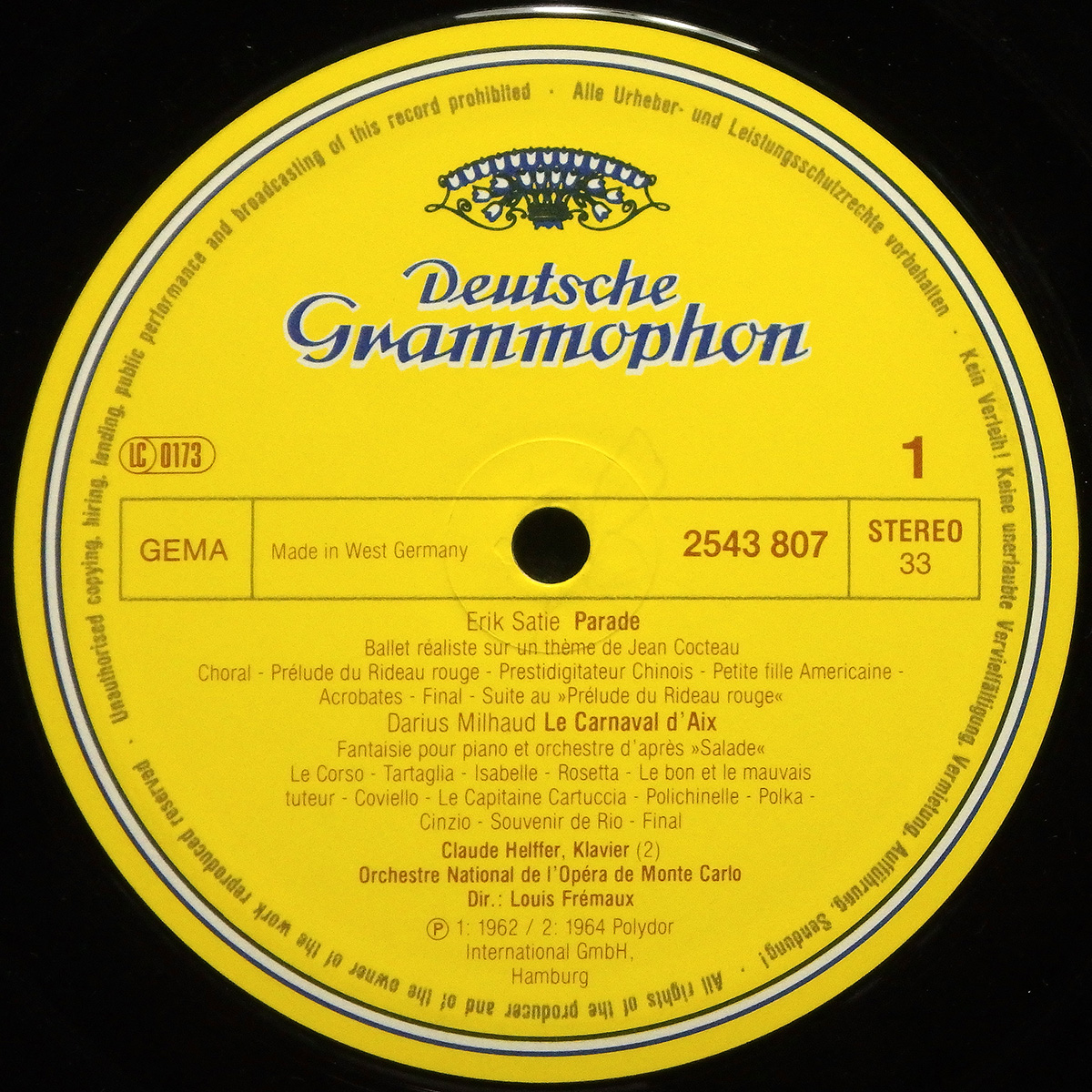 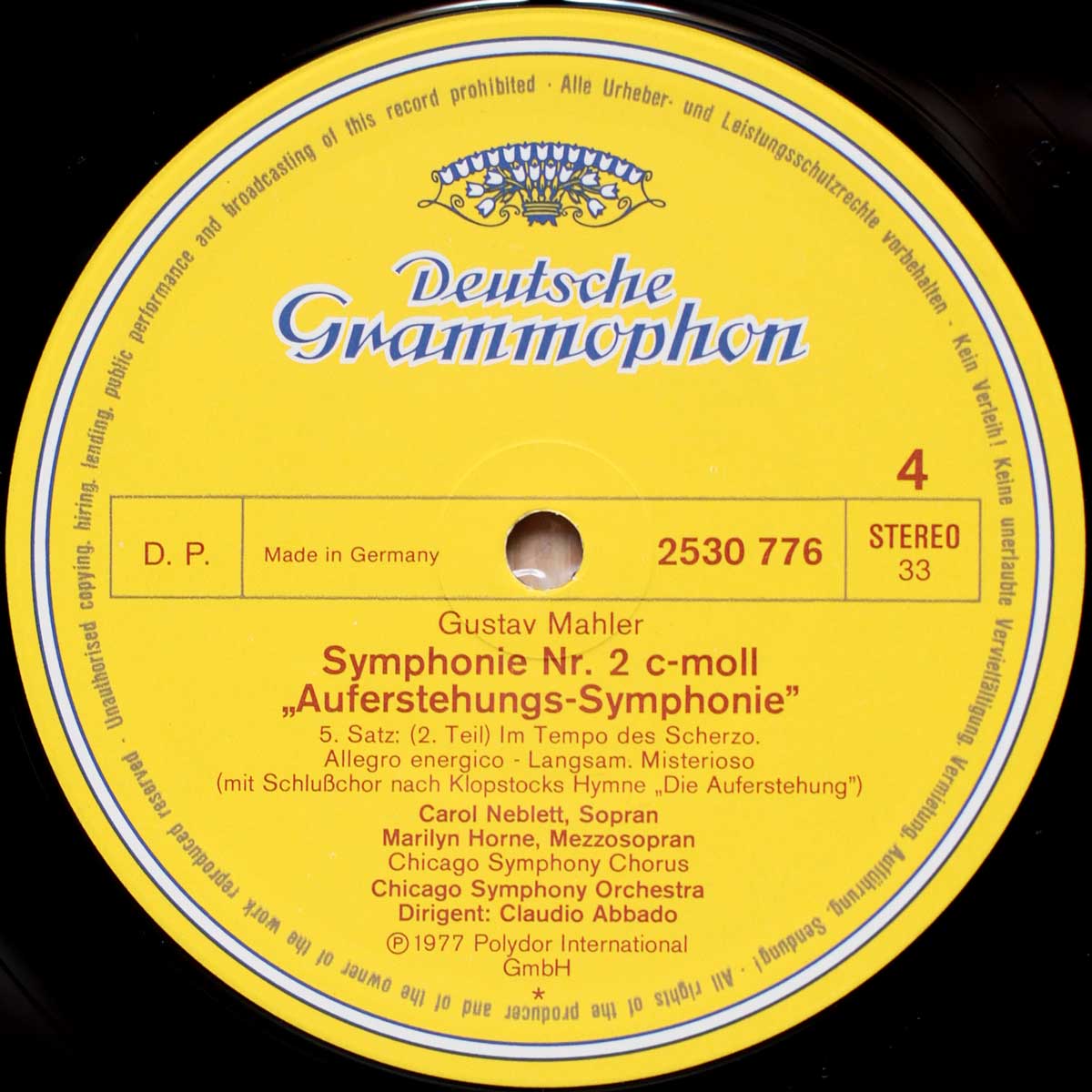 |
Série 7 digits – Stéréo
L’étiquette est similaire à la GY8. Le texte « Urheber und … » débute à 12 heures. La traduction de ce texte en anglais débute à 5 heures. Elle est appelée GY12 (German Yellow 12th). Il existe une variante avec une étoile située en bas de l’étiquette. The label is similat to the GY8. The text « Urheber und … » starts at 12 o’clock. The translation of this text into English starts at 5 o’clock. This is called GY12 (German Yellow 12th). There is a variant with a star at the bottom of the label. Thanks for his cooperation to Bill H. / Pittsburgh |
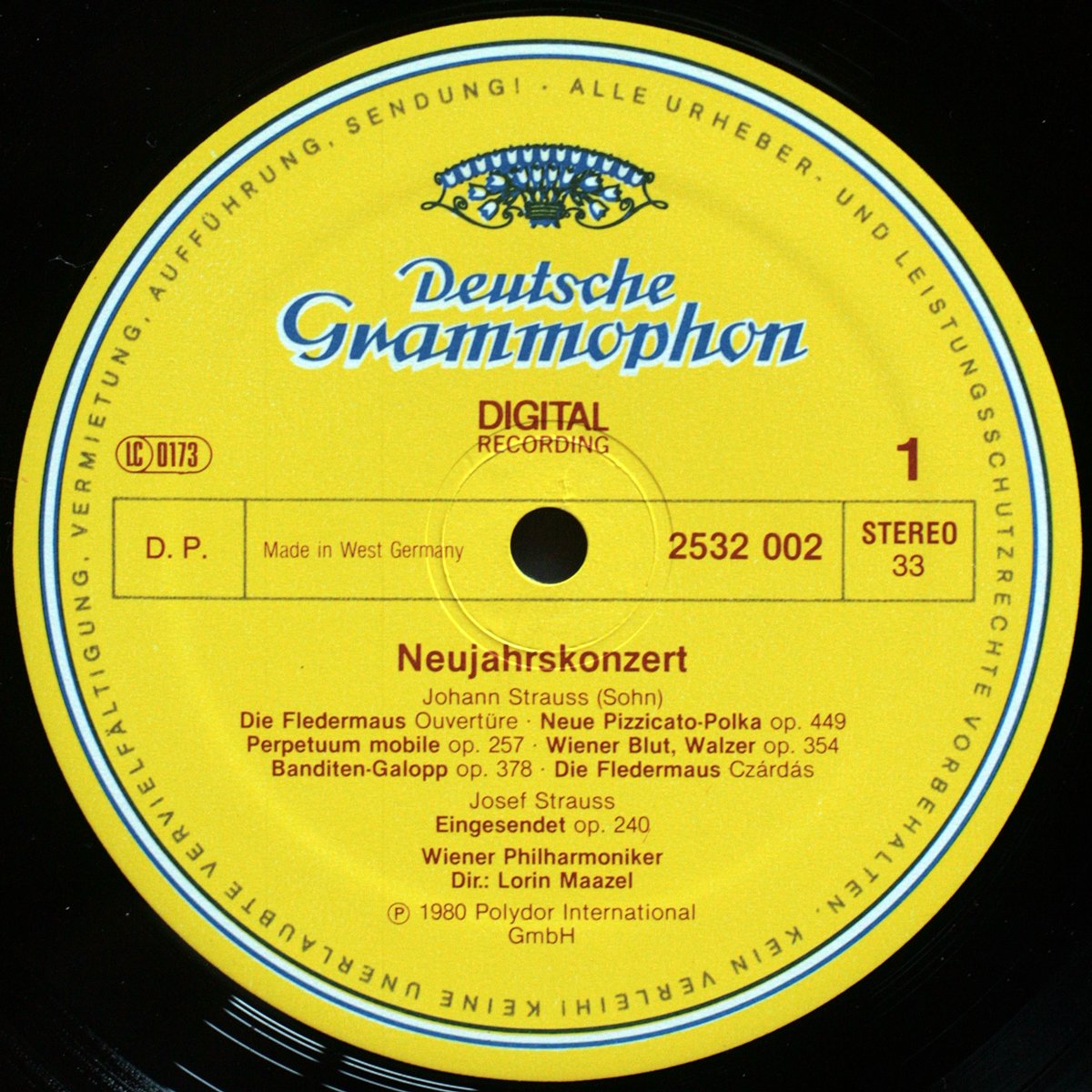 |
Série 7 digits – Stéréo – « Digital Recording »
L’étiquette est similaire à la GY8. Le logo « DIGITAL RECORDING » est situé entre le texte « Deutsche Grammophon » et le trou central. Le texte « Alle Urheber und … » débute à 12 heures. Elle est appelée GY13 (German Yellow 13th). The label is similat to the GY8. The « DIGITAL RECORDING » logo is located between the text « Deutsche Grammophon » and the center hole. The text « Alle Urheber und … » starts at 12 o’clock. This is called GY13 (German Yellow 13th). → Voir aussi le catalogue des enregistrements numériques (« Digital Aufnahme ») |
 |
Série LP – Tulip – 10″ – Mono
L’étiquette jaune est similaire à la LPM – 12″. Dans la partie supérieure se trouve le logo « Tulipe » avec le texte « Deutsche Grammophon Gesellschaft » et le texte « LP 33 1/3 » sur fond blanc. Un sillon circulaire près du trou central. L’étiquette a le texte « Alle Rechte … » sur le périmètre et un bord tulipe. Elle est appelée GY1 (German Yellow 1st). The yellow label is similar to the LPM label. At the upper half are the « Tulip » logo with the text « Deutsche Grammophon Gesellschaft, and the text « LP 33 1/3 » on white background. A circular groove near the center hole. The label has text « Alle Rechte … » around the perimeter and a tulip rim. This is called GY1 (German Yellow 1st). |
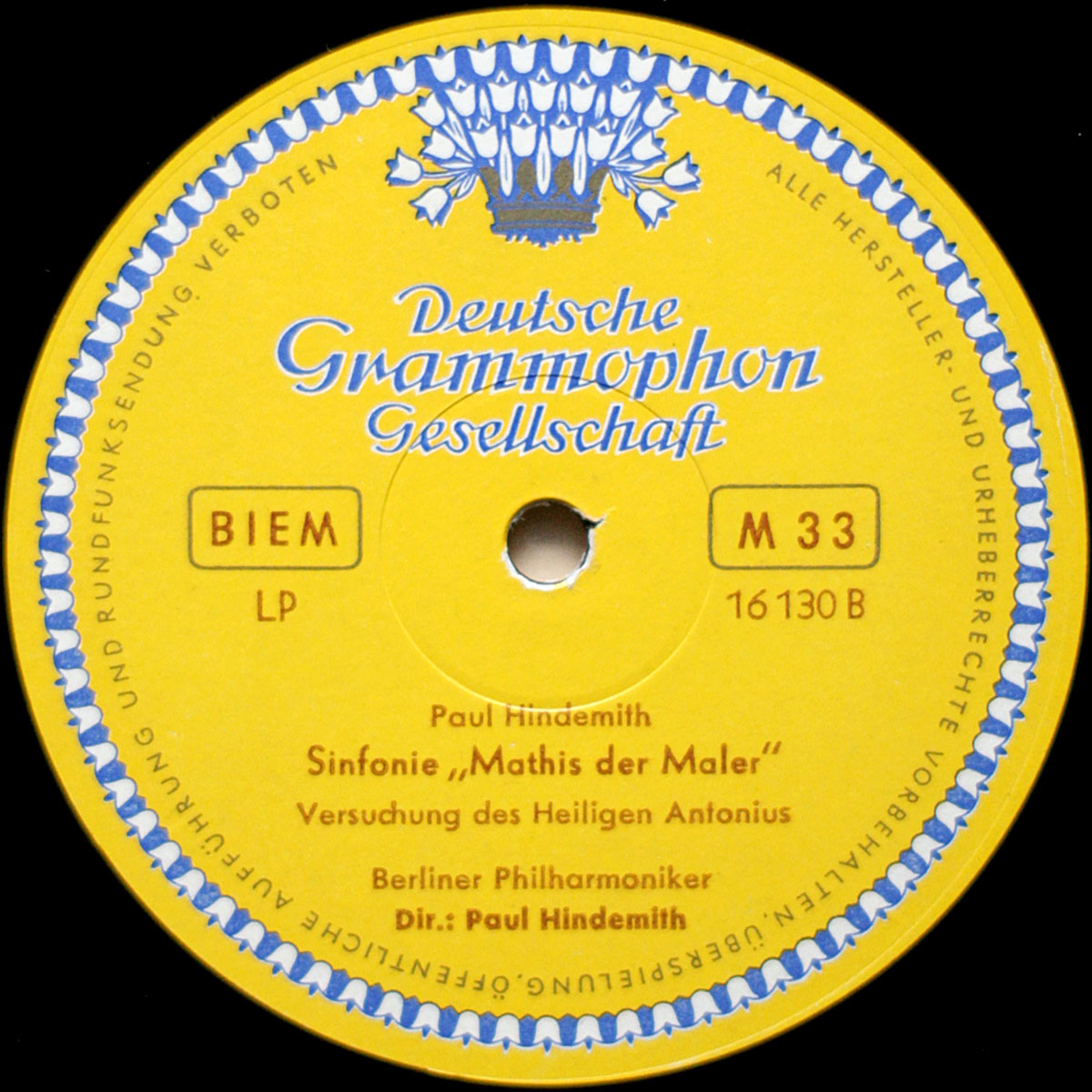 |
Série LP – Tulip – 10″ – Mono
L’étiquette est similaire à la LPM – 12″. Le texte « LP 33 1/3 » sur fond blanc disparaît et est remplacé par « M 33 » dans un cartouche rectangulaire. Un sillon circulaire près du trou central. L’étiquette a le texte « Alle Rechte … » sur le périmètre et un bord tulipe. Elle est appelée GY2 (German Yellow 2nd). The label is similat to the LPM label. The text « LP 33 1/3 » on white background disappearsand is replaced by « M 33 » in a rectangle cartridge. A circular groove near the center hole. The label has text « Alle Rechte … » around the perimeter and a tulip rim. This is called GY2 (German Yellow 2nd). |
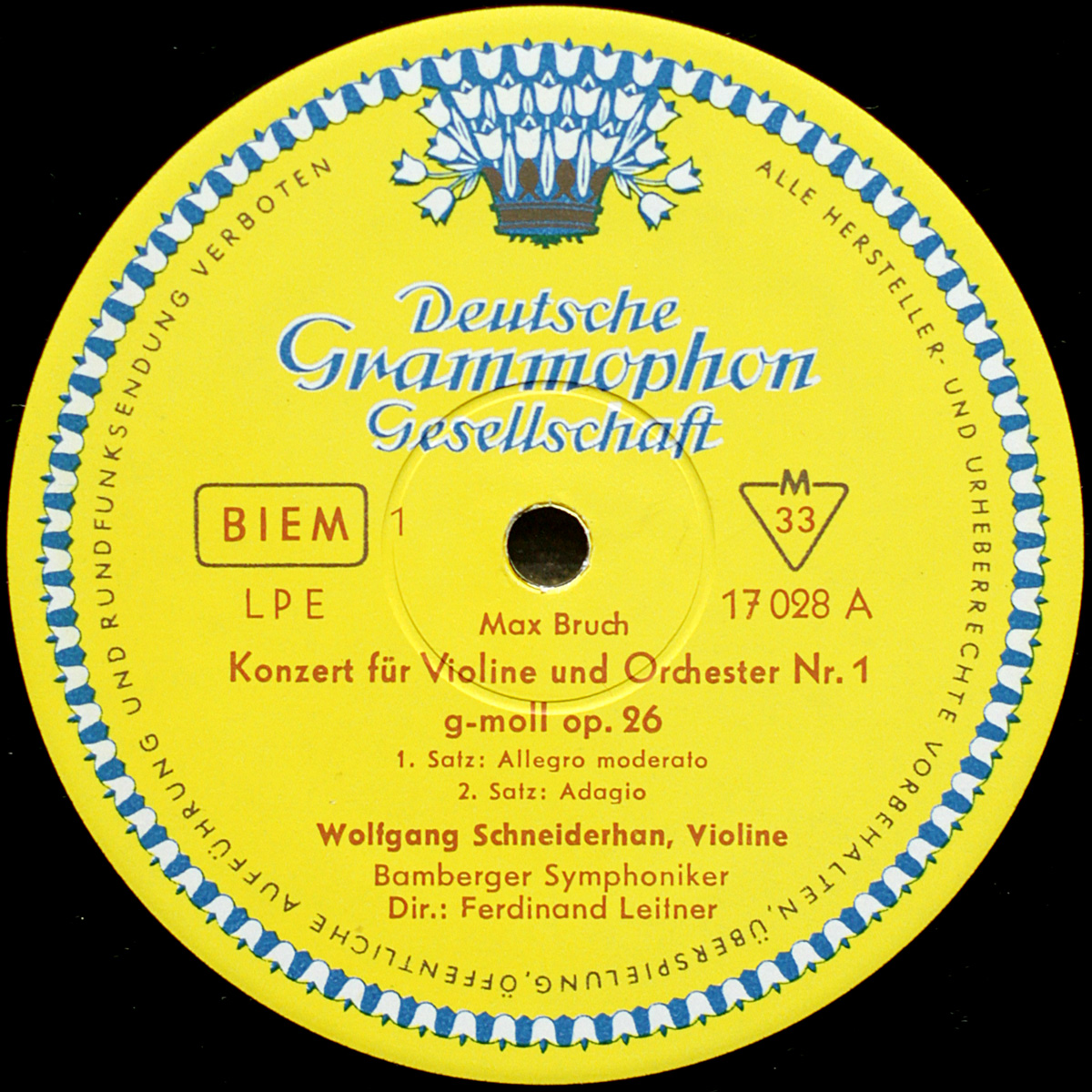 |
Série LPE – Tulip – 10″ – Mono
L’étiquette est similaire à la LPM – 12″. Le texte « M 33 » est dans un cartouche triangulaire. Un sillon circulaire près du trou central. L’étiquette a le texte « Alle Rechte … » sur le périmètre et un bord tulipe. Elle est appelée GY3 (German Yellow 3rd). The label is similat to the LPM label. The text « M 33 » is in a triangular cartridge. A circular groove near the center hole. The label has text « Alle Rechte … » around the perimeter and a tulip rim. This is called GY3 (German Yellow 3rd). |
 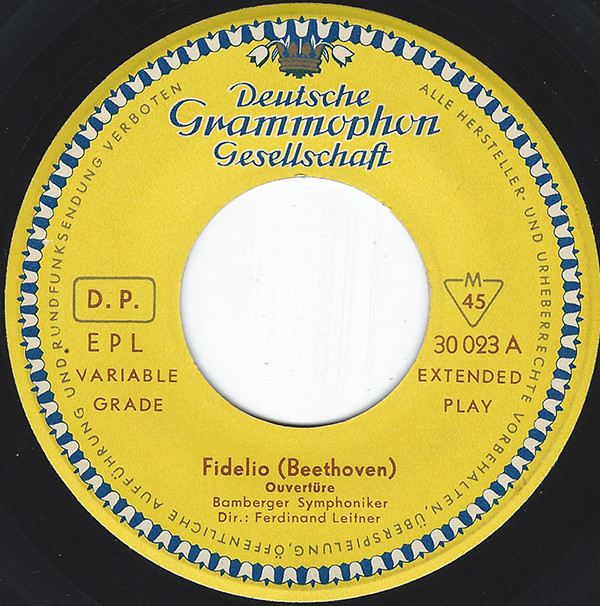  |
Série EPL – 7″ – 45 tours
Le disque 45 tours a rencontré un succès mondial dans le domaine de la chanson et de la musique populaire. Au début des années 1950, Deutsche Grammophon a également utilisé ce format pour des œuvres classiques courtes, telles que musique de chambre, ouvertures, « petites » symphonies , récitals ou extraits d’œuvres symphoniques et d’opéras. The 45-rpm record found worlwide fame in song and popular music. But in the early 1950, Deutsche Grammophon also used this format for small-scale classical works, such as chamber-music, overtures, « short » symphonies, recitals or excerpts from symphonic works and operas. |
